Modern Guest Bathroom Design: A Welcoming Retreat
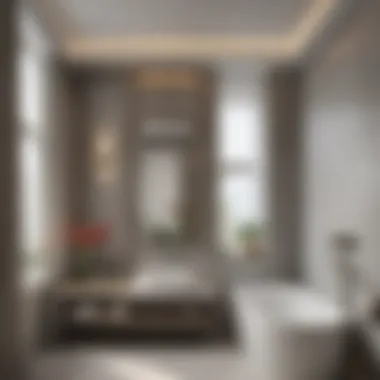
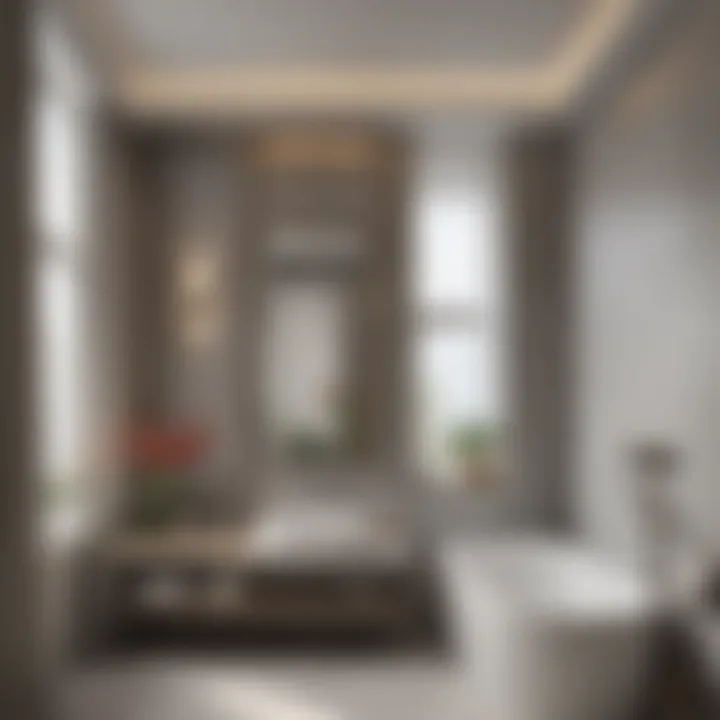
Intro
Creating a modern guest bathroom involves more than mere aesthetics. It requires a careful balance of style, functionality, and comfort. As a space that welcomes visitors, it should be inviting and practical. Understanding the dynamics of the layout, material selection, and fixture integration is crucial. Each element plays a role in shaping the overall experience of the space.
Guest bathrooms often reflect personal taste while also catering to the diverse needs of visitors. This article will delve deep into crucial aspects of modern bathroom design, focusing on optimizing space and enhancing user experience. It will touch upon smart technologies, eco-friendly practices, and stylish accessories, guiding homeowners on how to craft a restroom that feels both luxurious and comfortable.
Intro to Modern Guest Bathroom Design
In the realm of home design, the guest bathroom holds a significant role. It is often the first and sometimes only place where visitors experience the home's style and functionality beyond the main living spaces. Therefore, crafting a modern guest bathroom is not merely an aesthetic endeavor; it is a thoughtful approach to hospitality and comfort.
A modern guest bathroom blends contemporary design with practicality. This space must accommodate various needs, from quick visits to leisurely retreats. The choice of materials, colors, and layouts contributes heavily to creating an inviting atmosphere. Moreover, modern elements such as smart technology can elevate the functionality of the space while providing an upscale experience for guests.
Key elements of modern guest bathroom design emphasize:
- Efficient space planning to maximize usability.
- Durable materials that blend style with longevity.
- Intuitive fixtures and fittings for a seamless experience.
In this article, we will explore the essential components of modern guest bathroom design, considering both aesthetics and functionality. We will discuss how to create a welcoming environment that reflects personal style while being equipped for guests' diverse needs.
"A guest bathroom should feel like a seamless extension of the home, offering comfort and elegance without sacrificing functionality."
Ultimately, a well-designed guest bathroom is about creating an inviting sanctuary. It goes beyond simple utility; it reflects care, attention, and an understanding of guests' experiences. By focusing on modern design principles, homeowners can transform this essential space into a highlight of their home.
Defining Modern Aesthetics
Modern aesthetics represent a profound shift in design philosophy, emphasizing simplicity, functionality, and cleanliness. The importance of defining modern aesthetics in guest bathroom design cannot be overstated. This framework shapes not only the visual appeal of the space but also the overall experience it offers to visitors. Incorporating modern design principles ensures a bathroom is not just visually attractive but also exceptionally practical.
Characteristics of Modern Design
A few key characteristics define modern design in bathrooms. First, there is a strong inclination towards minimalism. This means reducing clutter and focusing on essential elements that create a serene atmosphere. Using geometric forms and clean lines enhances this clarity, thereby making the space feel more open and airy.
Natural light is another critical component. Large windows and glass elements can significantly elevate the ambiance. Here, bringing the outdoors inside plays a major role in achieving a harmonious environment. Also, materials like marble, glass, and metals are often utilized. They not only add an element of sophistication but also emphasize durability and ease of maintenance.
Finally, purpose-driven layouts which prioritize functionality are essential. Each component of the bathroom should serve a specific function while contributing to its overall appeal.
Popular Color Schemes
Choosing the right color scheme can dramatically influence the guest bathroom's atmosphere. Neutral palettes are often preferred. Colors such as whites, grays, and beige can serve as a calming foundation for the space. They are easy to accessorize and allow for flexibility in decor changes without requiring a complete remodel.
Adding bold accents can transform a neutral space into something visually intriguing.
- Deep navy or forest green accents can bring depth.
- Bright colors like aquamarine or coral can inject energy.
Furthermore, monochromatic schemes have also found favor among homeowners. These create a seamless look and feel, with various shades of the same color providing depth and interest.
In summation, defining modern aesthetics becomes a foundational step in crafting an inviting guest bathroom. It informs the choices made in terms of materials, colors, and layout, all aimed at creating a space that balances beauty with practicality.
A well-designed bathroom is an oasis of comfort and style, reflecting the owner's taste while serving the needs of guests.
Space Planning Essentials
Space planning is fundamental to modern guest bathroom design. It significantly impacts not only the aesthetic appeal but also the practical usability of the space. A well-planned layout ensures that the bathroom is both functional and comfortable for visitors. It also allows for smooth movement between different areas and optimizes the available square footage. When contemplating space planning, one must consider the specific needs of the users and the practical implications of appliance and fixture placement. This thoughtful approach can lead to an inviting atmosphere that enhances the overall user experience.
Understanding Space Utilization
Proper space utilization is about maximizing efficiency within a bathroom layout. This encompasses an analysis of how the space will be used daily and can lead to better functionality. An effective strategy involves measuring existing dimensions and considering the type of fixtures needed. Visitors will appreciate a guest bathroom where every inch of space has a purpose. Overcrowded rooms can feel claustrophobic, so identifying areas for essential fixtures—such as sinks, showers, and toilets—is vital.
To achieve this, designers should assess traffic flow and commonly used spaces. Unused nooks can be transformed into attractive storage areas or decorative features, enhancing both function and style.
Creating Functional Zones
Dividing the guest bathroom into functional zones is essential for creating a pleasing and practical layout. This organized approach allows for specific tasks to occur in designated spaces, thus streamlining the overall experience.
Vanity Area
The vanity area serves as a hub for personal grooming and storage. Its placement is crucial since it is often the first stop for guests. A well-designed vanity typically features ample counter space, storage for toiletries, and appropriate lighting. A double vanity setup can be a popular choice, allowing multiple users to utilize the space simultaneously.
The choice of materials and finishes for the vanity can contribute significantly to the overall aesthetic. For example, natural stone countertops blend elegance with functionality. However, consideration must be given to maintenance, as some surfaces can require more upkeep than others. The key characteristic of a well-planned vanity area is its balance of style and practicality.
Shower and Bath Zones
Shower and bath zones are integral parts of guest bathrooms. They create opportunities for relaxation and rejuvenation. A modern guest bathroom may feature a walk-in shower, which is not only spacious but also provides ease of access. If space allows, adding a soaking tub can enhance the luxury feel of a guest bathroom.
Both zones need to be meticulously planned for plumbing and drainage efficiency. It is crucial to decide on a single focus—either a shower or a bathtub, or both in combo—that aligns with the target audience's needs. A unique feature of contemporary designs is the use of rainfall showerheads, adding a spa-like experience within the bathroom's confines.
Toilet Placement
Toilet placement in a guest bathroom requires careful thought. While it is often a less glamorous aspect, its positioning can affect both aesthetics and comfort. Placing the toilet away from immediate view can enhance privacy and promote a more refined setting.
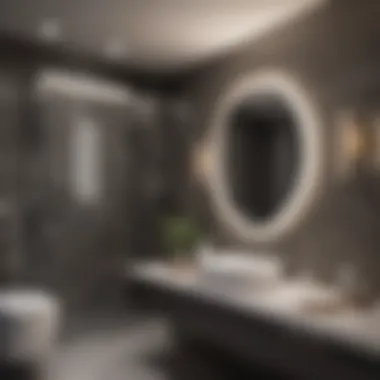
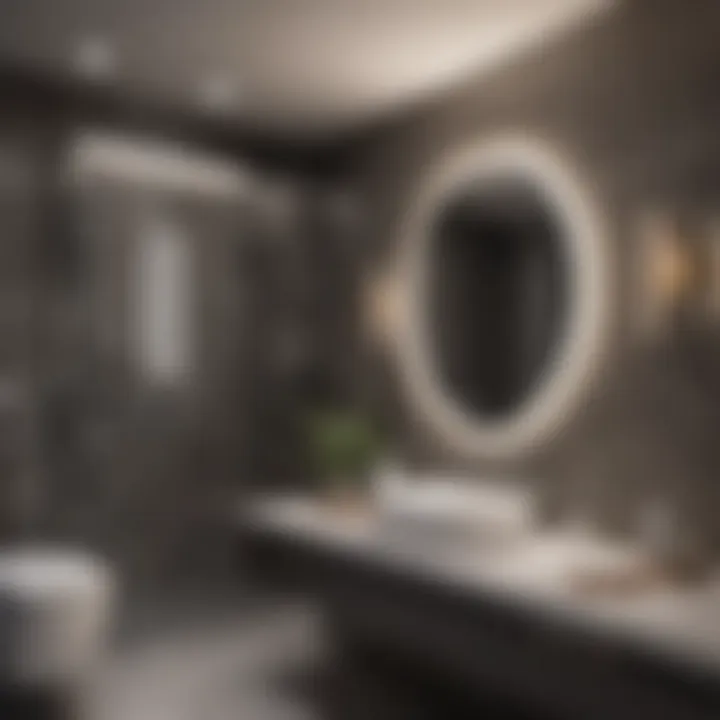
The key characteristic here is discretion. Many modern layouts incorporate partial walls or strategic placements behind a divider to blend functionality with design integrity. When designing the guest bathroom, aiming for a discreet yet accessible location is recommended. This balance can significantly enhance guest comfort during their stay.
Material Selection for Durability and Style
The choice of materials in a guest bathroom is fundamentally significant, as it impacts both the aesthetic appeal and the durability of the space. Selecting the right materials ensures that the bathroom can withstand daily use while still looking visually pleasing. Durable materials can minimize maintenance efforts, which is an important consideration for a guest bathroom that serves as a welcoming space for visitors. Therefore, understanding how different materials contribute to both style and functionality is essential when designing a modern guest bathroom.
Choosing Tiles and Surfaces
Tiles and surfaces form the foundation of any bathroom design. They influence not only the look but also how the space feels. Popular tile options include ceramic, porcelain, and natural stone. Each option has distinct benefits. For example, porcelain tiles are highly durable and resistant to moisture, making them ideal for countertops and walls. In contrast, natural stone offers a unique and upscale appearance but may require more maintenance. Choosing the right finish is also important. Glossy finishes reflect light, making the space feel brighter, but they may show smudges and water spots more easily than matte finishes. Ultimately, the decision should revolve around a balanced mix of style and practicality.
Countertops: Options and Considerations
Countertops play a critical role in bathroom functionality and style. Common materials for bathroom countertops include granite, quartz, and laminates. Granite offers a striking look with unique patterns, and it is exceptionally durable. However, it can be costly and might require sealing to prevent stains. Quartz, on the other hand, is engineered, presenting consistent patterns and colors, and is generally less porous than granite, minimizing maintenance needs. Laminate is a budget-friendly option that offers numerous designs but lacks the durability of stone options. When selecting a countertop material, consider factors such as budget, maintenance requirements, and overall design aesthetic of the bathroom.
Fixtures and Fittings: Aesthetic and Functional Choices
Fixtures and fittings are vital components that not only serve functional purposes but also define the style of the bathroom. They include sinks, faucets, and showerheads. The right choice enhances convenience and complements the overall design.
Sink Options
When evaluating sink options, both style and utility should be considered. Popular choices include undermount, vessel, and pedestal sinks. Undermount sinks offer a modern look, are easy to clean, and create a seamless surface with the countertop, making them a popular choice in modern designs. On the other hand, vessel sinks come in various shapes and colors, acting as a statement piece in the bathroom. They sit on top of the counter, thus needing careful positioning to ensure usability. Each type has its advantages and disadvantages, so it is critical to think about space, height, and design coherence when selecting a sink.
Faucets and Showerheads
Faucets and showerheads are essential fixtures that can enhance both the functionality and aesthetic of a bathroom. For faucets, both the design and ease of use matter. Single-handle faucets offer simplicity and are easier to operate, while dual-handle options provide more control over water temperature but can complicate usage. For showerheads, consider options like overhead rain showerheads or handheld varieties. Rain showerheads give a luxurious feel but may require a higher ceiling height for effective installation. Each type has its unique features, and it is prudent to evaluate how they will fit into the space and the tailored experience you wish to create.
Incorporating Smart Technology
In modern guest bathroom design, the integration of smart technology plays a pivotal role. As homeowners and those who host guests increasingly seek convenience and efficiency, smart features enhance the overall bathroom experience. These technologies offer better control over various elements, facilitating a seamless blend of functionality and luxury. Importantly, they cater to a diverse range of user needs, ensuring that the bathroom remains both appealing and easy to use.
It is essential to consider the specific elements that can be included when incorporating smart technology. This may include smart lighting systems, automated faucets, and heated floors. Each of these features elevates the comfort of the space. Moreover, they allow guests to enjoy more customizable settings that suit their preferences, contributing to a uniquely tailored experience.
Smart Controls and Features
Smart controls are at the forefront of innovative bathroom design. These systems give users seamless access to adjust lighting, temperature, and even shower settings through their smartphones or tablets. With smart lighting, for instance, users can choose different color temperatures to create a calming mood or awakening brightness.
"Smart technology transforms mundane routines into a personalized experience, enhancing comfort and efficiency in modern bathrooms."
Additionally, automated features can enhance safety and sustainability. Water-saving faucets and showerheads can help in reducing water usage without compromising performance. Integrating these technologies also allows for proactive maintenance reminders, informing homeowners about potential clogs or leaks before significant issues arise.
Voice Activation and Integrated Systems
Voice activation technology is becoming more common in guest bathrooms. Systems like Amazon Alexa or Google Assistant can manage a variety of tasks simply through voice commands. This feature enables users to adjust lighting or activate the shower without needing to touch any surfaces.
Moreover, integrated systems can control multiple fixtures from a single interface. This unity makes it easier to maintain a cohesive experience within the bathroom. Guests can personalize their experience by adjusting features to their own preferences without needing to navigate complex settings.
Lighting: Creating Ambiance
Lighting plays a crucial role in the design of a modern guest bathroom. It affects not only the visual appeal of the space but also the mood and functionality. Proper lighting can transform a simple bathroom into an inviting haven. Moreover, different lighting layers can serve various needs, from bright task lighting for grooming to soft ambient lighting for relaxation.
Layering Lighting Elements
Layering is a key strategy in bathroom lighting. It helps to create depth and versatility. The main types of lighting to consider include:
- Task Lighting: This is essential for activities like shaving or makeup application. It often comes from fixtures placed above or beside mirrors.
- Ambient Lighting: This provides overall illumination to the space. Ceiling lights or recessed lighting are common choices for this purpose.
- Accent Lighting: Use this to highlight architectural features or artwork. It adds a touch of elegance and draws attention to specific areas.
Combining these types of lighting allows for adjustments throughout the day and creates a more dynamic atmosphere. Also, dimmer switches are a practical addition, giving you control over brightness levels.
Choose the Right Fixtures
Selecting the right fixtures is vital in achieving effective lighting. Considerations for choosing suitable fixtures include:
- Style: Modern fixtures should align with the overall design of the bathroom. Sleek lines and minimalistic designs are popular in contemporary settings.
- Functionality: Ensure the fixtures produce sufficient light for tasks. For mirrors, sconces with a warm light are especially effective.
- Energy Efficiency: LED fixtures are often recommended due to their durability and lower energy consumption.
Overall, the right lighting fixtures will not only enhance your bathroom’s aesthetics but also improve its functionality.
"A well-lit bathroom can enhance the overall guest experience, making it feel not just functional but also inviting."
Enhancing Comfort and Luxury
Creating an inviting guest bathroom requires thoughtful consideration of comfort and luxury. These elements distinguish a basic bathroom from one that offers a truly enjoyable experience. Comfort in the guest bathroom ensures that visitors feel relaxed and at ease, while luxury provides a touch of elegance and sophistication. To achieve this balance, various specific elements should be incorporated.
Selecting Quality Towels and Linens
Quality towels and linens are fundamental for enhancing comfort in the guest bathroom. Soft, plush towels invite guests to indulge themselves. Using materials like Egyptian cotton or bamboo ensures a soft touch and good absorbency, which adds a layer of indulgence. Additionally, choose linens that complement the overall design theme of the bathroom, providing visual harmony.
To select the best quality towels and linens:
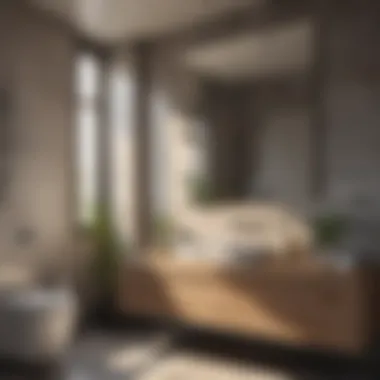

- Material: Look for natural fibers; they are usually softer and last longer.
- GSM Rating: A higher grams per square meter (GSM) means thicker, more absorbent towels.
- Color Coordination: Choose colors that align with the bathroom's palette to create a cohesive look.
Incorporating Relaxation Elements
Incorporating relaxation elements transforms a simple guest bathroom into a spa-like retreat. This theme emphasizes tranquility and well-being, allowing guests to unwind thoroughly during their stay.
Spa-like Features
The inclusion of spa-like features significantly contributes to creating a soothing environment. Key characteristics of such features involve elements like rainfall showerheads, freestanding bathtubs, and soaking tubs. These not only appear visually appealing but also provide practical advantages for relaxation.
- Key Characteristic: Rainfall showerheads mimic natural rainfall, offering a rejuvenating experience.
- Benefits: Freestanding tubs can serve as a focal point, contributing to the luxury aesthetic while providing comfort during long baths.
However, specific considerations must be addressed. Ensuring enough space is critical for features like bathtubs, which can be large. Moreover, choosing fixtures that align with the overall design style helps maintain coherence.
Adding Greenery
Another essential aspect of creating a relaxing atmosphere in a guest bathroom is incorporating greenery. Indoor plants enhance aesthetic appeal while providing several psychological benefits. They help in improving air quality and promoting a sense of peace.
- Key Characteristic: Plants like snake plants or peace lilies are known for their low maintenance and air-purifying properties.
- Benefits: Adding greenery can also visually soften the stark lines of modern design, creating a more inviting space.
When designing, consider the placement of plants to avoid clutter. Use stylish pots to complement the bathroom decor while keeping essential maintenance in mind.
Eco-Friendly Bathroom Practices
As modern society becomes more aware of environmental issues, eco-friendly bathroom practices are increasingly viewed not just as optional but as essential. Implementing these techniques allows homeowners to contribute to a sustainable future while enhancing the functionality and aesthetic of their guest bathroom. By focusing on resource conservation and efficiency, these practices can lead to significant cost savings as well.
Water-Saving Fixtures
Water-saving fixtures play a crucial role in reducing water wastage in the bathroom. Modern toilets, faucets, and showerheads are designed to use less water without sacrificing performance. For instance, low-flow toilets can use under 1.6 gallons per flush, compared to older models that may consume up to 4 gallons. This not only helps in conserving water but also reduces the water bill.
When selecting faucets, look for models with aerators that mix air with water. This creates a steady flow while using less resource. Similarly, showerheads with high-efficiency ratings can cut water usage significantly, often by half or more, while still providing an enjoyable shower experience.
Adopting these fixtures is an effective step toward eco-friendliness. They contribute positively to the environment and reduce the household's impact on water sources.
Sustainable Materials and Accessories
The choice of materials in a bathroom design can considerably affect its environmental footprint. Opting for sustainable materials is one way to foster eco-friendly practices. For example, bamboo is a highly renewable resource and is increasingly being used for vanities, cabinets, and accessories. It grows quickly and doesn't require chemicals to thrive, making it an excellent choice.
Similarly, recycled materials should be considered for flooring and countertops. Items made from reclaimed wood or recycled glass can be as durable and stylish as traditional options while minimizing the environmental impact.
Additionally, when selecting bathroom accessories, focus on products that have sustainable packaging or are made from eco-friendly materials. Natural fiber textiles, such as organic cotton towels, not only feel luxurious but also avoid the harmful chemicals found in conventional textiles.
"Implementing eco-friendly practices in your bathroom design is not just a trend; it’s a commitment to a sustainable future that pays off in the long run."
Incorporating eco-friendly practices in a guest bathroom does more than just benefit the environment. It provides a healthier space for users, reduces costs over time, and aligns with the growing movement toward sustainability in our homes.
Access and Inclusivity in Modern Bathrooms
Access and inclusivity are vital aspects of modern bathroom design. They ensure that spaces are accommodating for people of all ages and abilities. Failing to consider these factors can limit the functionality of guest bathrooms, impacting the user experience negatively. This section highlights key elements, benefits, and considerations necessary for creating an inclusive space.
Design Considerations for All Users
When designing a guest bathroom, it is important to think about how all users will access and use the space. This includes children, elderly family members, and individuals with disabilities. Consider the following:
- Door Width: Ensure doors are wide enough for wheelchair access. Standard door widths may need to be increased to at least 32 inches.
- Flooring: Opt for slip-resistant flooring to prevent falls. Smooth surfaces are often difficult for those using mobility aids.
- Height of Fixtures: Install sinks, toilets, and countertops at various heights to accommodate different users.
- Clear Floor Space: Maintain sufficient space for maneuvering. A turning radius of at least five feet for wheelchairs is ideal.
Each of these design considerations enhances user experience and demonstrates thoughtfulness in your design choices.
Incorporating Universal Design Elements
Universal design refers to products and environments that are accessible to everyone, regardless of their age or ability. By including elements of universal design in a bathroom, we promote independence and confidence for all users. Some key elements to consider are:
- Grab Bars: Incorporate sturdy grab bars near the toilet and in the shower or bathtub to assist with standing up or sitting down.
- Lever Handles: Install lever handles on faucets and cabinets, which are easier to use than traditional knobs.
- Shower Design: Walk-in showers with low or no thresholds provide easier access than traditional bathtubs. Consider adding a shower seat for added comfort.
- Adjustable Showerheads: These provide flexibility in height and direction, accommodating all users.
Inclusive designs not only benefit those with disabilities but also enhance the overall experience for everyone.
By focusing on access and inclusivity in bathroom design, you create a welcoming space that serves everyone effectively. This approach also showcases a commitment to thoughtful living and hospitality, ensuring guests feel respected and valued.
Trends in Guest Bathroom Decor
The evolution of guest bathroom decor reflects broader changes in lifestyle, preferences, and technology. In this section, we examine how current trends shape the overall guest experience. Understanding these elements allows homeowners to create spaces that are not only luxurious but also functional and inviting for guests. Emphasizing decor trends can significantly enhance the bathroom's ambiance, making it a memorable retreat rather than just a utility space.
Current Design Trends
Modern design trends focus on minimalism and functionality while still incorporating style. One major trend is the use of natural materials like wood and stone. These materials offer warmth and character to an otherwise sterile environment. In contrast, materials like glass and metal can create a sleek, modern appeal.
Another noteworthy trend is the incorporation of bold colors. Soft hues remain popular, yet there is a noticeable shift towards deeper colors such as navy and emerald green. These colors evoke a sense of calm while adding depth to the space.
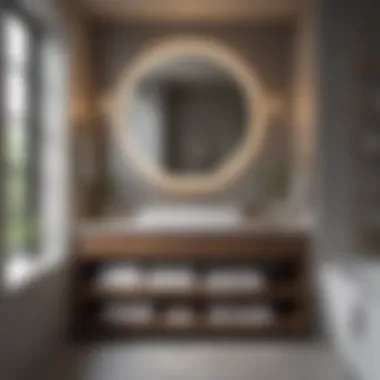
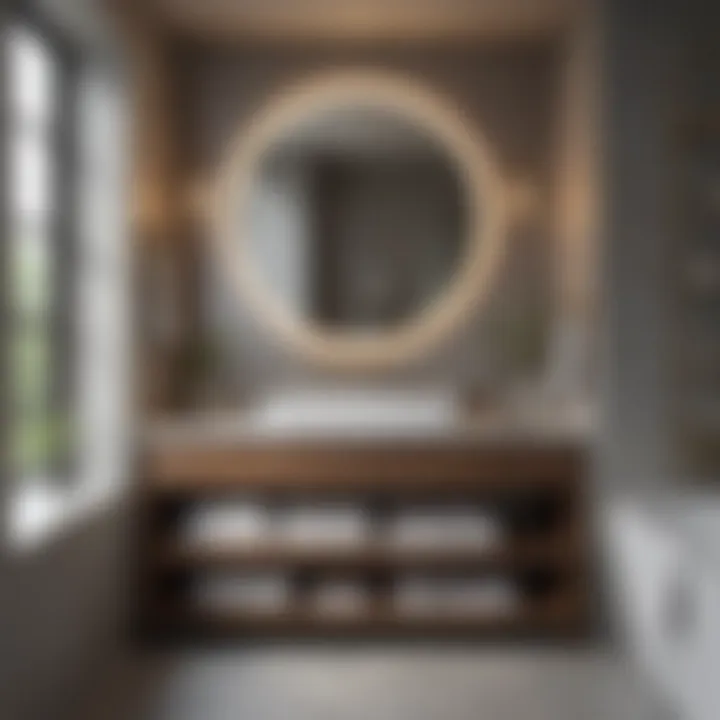
Moreover, vintage elements are making a comeback. For example, using antique fixtures or decor items can provide an interesting contrast to modern features. This blend of old and new creates a unique aesthetic that can appeal to various tastes.
Benefits of Following Trends:
- Enhances the visual appeal of the bathroom.
- Allows for personal expression in design choices.
- Provides functionality without sacrificing style.
Timeless Aesthetic Choices
While trends come and go, certain aesthetic choices remain perennial favorites. These timeless elements can anchor the design, providing a lasting foundation that complements seasonal updates. Classic white tiles, for instance, are known for their versatility and ability to reflect light, making spaces appear larger.
In addition, incorporating traditional vanity styles, such as pedestal sinks or vintage cabinetry, creates a sense of elegance and charm. These styles can seamlessly blend with modern fixtures, creating an eclectic yet coordinated look.
Lighting is another crucial component.
- Sconces: Often placed on either side of mirrors, sconces can contribute to both style and function.
- Chandeliers: For a touch of luxury, a well-selected chandelier can act as a statement piece.
Ultimately, the best designs reflect the homeowner's personality while ensuring comfort and functionality for guests. Integrating timeless choices within a framework of modernity can make a guest bathroom feel both welcoming and sophisticated.
"A guest bathroom should reflect the hospitality of the home, balancing style and comfort."
Through understanding current trends and timeless choices, homeowners can create an inviting space. A well-designed guest bathroom can enhance the overall experience for visitors, ensuring their comfort and satisfaction.
Bathroom Accessories: The Finishing Touches
In the realm of modern guest bathroom design, accessories serve as critical components that enhance the overall aesthetic and functionality of the space. These finishing touches can transform a basic setup into a truly inviting retreat for guests. They not only contribute to the visual appeal but also improve the user experience by providing necessary conveniences. Consequently, selecting the right accessories requires careful thought and consideration.
Selecting Complementary Accessories
Choosing complementary accessories is crucial because they need to harmonize with the existing decor and color scheme. Opt for items that reflect the overall theme of the bathroom, be it minimalist, contemporary, or classic. Accessories like soap dispensers, towel holders, and waste bins can reinforce the design strategy. For instance, if you opt for a sleek, modern appearance, consider stainless steel or matte black fixtures.
When selecting accessories, keep these factors in mind:
- Material Quality: Durability is key. Accessories should withstand frequent use.
- Practicality: Items should serve a purpose and aid in keeping the space organized.
- Proportion: Accessories must be the right size for the space to avoid clutter.
Art and Decor Elements
Art and decor elements are essential in creating a personalized atmosphere within the guest bathroom. Simple decor, such as framed prints or artistic mirrors, can infuse character into the space. Plants or flowers can enhance freshness while adding a pop of color. Wall-mounted shelves allow for both storage and display, enabling personal touches that reflect the host’s style.
Consider these suggestions when adding art and decor:
- Wall Art: Choose pieces that evoke serenity or amusement, depending on your aim. A calming landscape can enhance a spa-like atmosphere.
- Functional Decor: Decorative items should also serve a function. For example, aesthetic jars can store cotton balls or swabs while adding style.
- Lighting Elements: Unique light fixtures can double as art pieces, contributing both illumination and design.
"Accessories may seem trivial, but they are vital in achieving a well-rounded look for your bathroom."
Maintenance of Modern Guest Bathrooms
Maintaining a modern guest bathroom is crucial for ensuring its longevity, cleanliness, and overall appeal. A well-maintained space reflects a commitment to hospitality and comfort while meeting the practical needs of guests. Regular upkeep not only enhances aesthetic value but also supports hygiene standards essential in shared spaces.
Regular maintenance includes both routine cleaning and preventive measures that can save time and costs in the long run. It helps to avoid complex repairs, ensures that fixtures remain in good working order, and provides a welcoming atmosphere for visitors. Keeping this balance is paramount for homeowners aiming to impress their guests and make them feel at home.
Regular Cleaning Routine Tips
An effective cleaning routine is the backbone of bathroom maintenance. Here are essential tips to optimize your cleaning efforts:
- Daily Cleaning: Clean high-touch surfaces daily. Wipe down faucets, counters, and handles to prevent buildup of grime.
- Deep Cleaning Weekly: Set aside time each week for a more thorough cleaning. Scrub toilets, sinks, and tubs to remove stains and prevent soap scum.
- Mold Prevention: Maintain ventilation to reduce humidity. Consider using exhaust fans during showers and leave doors open to promote airflow.
- Stock Up on Supplies: Have cleaning supplies readily available—this includes disinfectants, scrubbing brushes, and microfiber cloths.
- Tackle Grout and Tile: Apply a grout cleaner periodically. This preserves the integrity of tiles and prevents stains from setting.
Preventive Maintenance Strategies
Preventive maintenance strategies are essential to mitigate wear and tear in a guest bathroom. Consider the following approaches:
- Inspect Fixtures Regularly: Check for leaks in sinks and toilets. Addressing these issues promptly can prevent costly repairs later on.
- Water Softener Installation: If hard water is an issue, a water softener can prolong the life of your plumbing fixtures and appliances.
- Seal Grout and Caulking: Apply sealant to grout and caulking to keep moisture out and avoid mold growth.
- Wardrobe Check for Linens: Regularly inspect towels and linens for wear. This ensures guests always have clean and comfortable options.
- Smart Maintenance Scheduling: Schedule seasonal maintenance checks to address any larger issues—such as plumbing or electrical concerns—before they escalate.
"A well-planned maintenance routine not only preserves the beauty of your modern guest bathroom but also enhances the overall guest experience."
By adhering to these practices, homeowners can transform maintenance from a cumbersome task into a systematic routine that ensures their guest bathrooms remain inviting and functional.
Closure: The Future of Guest Bathroom Design
The landscape of guest bathroom design is changing rapidly. This dramatic evolution emphasizes the need for a space that combines style, usability, and comfort. Various factors influence the future of these bathrooms, reflecting broader trends in home design and technology.
Firstly, sustainability is becoming a high priority. Consequently, eco-friendly materials and water-saving fixtures have emerged as valuable investments for both personal and environmental well-being. Homeowners are increasingly interested in making choices that reflect their values and contribute positively to the sustainability of their living environment.
Secondly, the integration of smart technology is on the rise. Features like touchless faucets, automated lighting, and voice-activated controls enhance comfort and convenience. As these technologies evolve, they promise to offer even more benefits, potentially transforming how guests interact with the space. Homeowners must consider how smart solutions can elevate the user experience, catering to the diverse needs of all visitors.
Moreover, with the growing trend of minimalist design, future guest bathrooms will likely continue to prioritize simplicity and functionality. Clutter-free spaces with streamlined organization create a sense of calm. Homeowners will focus on selecting fewer, quality items that make a statement while enhancing the space's functionality.
Aesthetic appeal will also endure as a critical consideration. This includes selecting colors, textures, and patterns that create a cohesive vision. The balance of contemporary design with personal touches can make any guest bathroom feel welcoming and unique.
In summary, the future of guest bathroom design is centered on several key elements:
- Sustainable Practices: Focus on eco-friendly options.
- Smart Technology: Enhance functionality with modern gadgets.
- Minimalist Aesthetic: Emphasize simplicity and ease of use.
- Aesthetic Appeal: Create a reflective and inviting environment.
"A well-designed bathroom can enhance a guest's experience and leave a lasting impression."
Incorporating these elements not only meets contemporary standards but also ensures that guest bathrooms remain adaptable to changing lifestyles and preferences. As homeowners continue to examine their spaces critically, the way we design and utilize guest bathrooms will evolve, reflecting our values and lifestyles.















